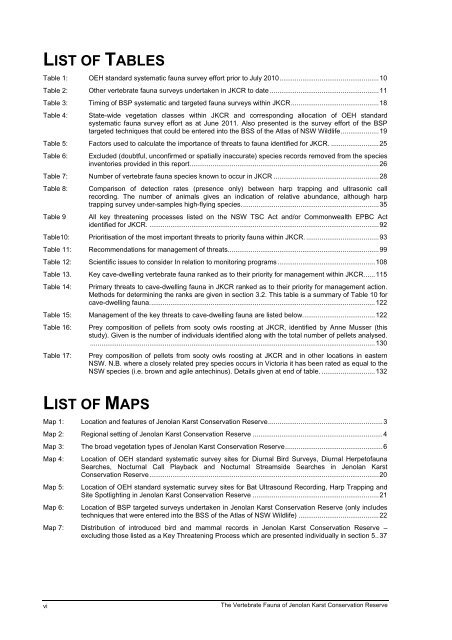The Vertebrate Fauna of Jenolan Karst Conservation Reserve: Final
The Vertebrate Fauna of Jenolan Karst Conservation Reserve: Final
The Vertebrate Fauna of Jenolan Karst Conservation Reserve: Final
You also want an ePaper? Increase the reach of your titles
YUMPU automatically turns print PDFs into web optimized ePapers that Google loves.
LIST OF TABLES<br />
Table 1: OEH standard systematic fauna survey effort prior to July 2010....................................................10<br />
Table 2: Other vertebrate fauna surveys undertaken in JKCR to date .........................................................11<br />
Table 3: Timing <strong>of</strong> BSP systematic and targeted fauna surveys within JKCR..............................................18<br />
Table 4: State-wide vegetation classes within JKCR and corresponding allocation <strong>of</strong> OEH standard<br />
systematic fauna survey effort as at June 2011. Also presented is the survey effort <strong>of</strong> the BSP<br />
targeted techniques that could be entered into the BSS <strong>of</strong> the Atlas <strong>of</strong> NSW Wildlife....................19<br />
Table 5: Factors used to calculate the importance <strong>of</strong> threats to fauna identified for JKCR. .........................25<br />
Table 6: Excluded (doubtful, unconfirmed or spatially inaccurate) species records removed from the species<br />
inventories provided in this report...................................................................................................26<br />
Table 7: Number <strong>of</strong> vertebrate fauna species known to occur in JKCR .......................................................28<br />
Table 8: Comparison <strong>of</strong> detection rates (presence only) between harp trapping and ultrasonic call<br />
recording. <strong>The</strong> number <strong>of</strong> animals gives an indication <strong>of</strong> relative abundance, although harp<br />
trapping survey under-samples high-flying species........................................................................35<br />
Table 9 All key threatening processes listed on the NSW TSC Act and/or Commonwealth EPBC Act<br />
identified for JKCR. ........................................................................................................................92<br />
Table10: Prioritisation <strong>of</strong> the most important threats to priority fauna within JKCR. ......................................93<br />
Table 11: Recommendations for management <strong>of</strong> threats...............................................................................99<br />
Table 12: Scientific issues to consider In relation to monitoring programs ...................................................108<br />
Table 13. Key cave-dwelling vertebrate fauna ranked as to their priority for management within JKCR......115<br />
Table 14: Primary threats to cave-dwelling fauna in JKCR ranked as to their priority for management action.<br />
Methods for determining the ranks are given in section 3.2. This table is a summary <strong>of</strong> Table 10 for<br />
cave-dwelling fauna......................................................................................................................122<br />
Table 15: Management <strong>of</strong> the key threats to cave-dwelling fauna are listed below......................................122<br />
Table 16: Prey composition <strong>of</strong> pellets from sooty owls roosting at JKCR, identified by Anne Musser (this<br />
study). Given is the number <strong>of</strong> individuals identified along with the total number <strong>of</strong> pellets analysed.<br />
.....................................................................................................................................................130<br />
Table 17: Prey composition <strong>of</strong> pellets from sooty owls roosting at JKCR and in other locations in eastern<br />
NSW. N.B. where a closely related prey species occurs in Victoria it has been rated as equal to the<br />
NSW species (i.e. brown and agile antechinus). Details given at end <strong>of</strong> table. ............................132<br />
LIST OF MAPS<br />
Map 1: Location and features <strong>of</strong> <strong>Jenolan</strong> <strong>Karst</strong> <strong>Conservation</strong> <strong>Reserve</strong>............................................................3<br />
Map 2: Regional setting <strong>of</strong> <strong>Jenolan</strong> <strong>Karst</strong> <strong>Conservation</strong> <strong>Reserve</strong> ....................................................................4<br />
Map 3: <strong>The</strong> broad vegetation types <strong>of</strong> <strong>Jenolan</strong> <strong>Karst</strong> <strong>Conservation</strong> <strong>Reserve</strong>...................................................6<br />
Map 4: Location <strong>of</strong> OEH standard systematic survey sites for Diurnal Bird Surveys, Diurnal Herpet<strong>of</strong>auna<br />
Searches, Nocturnal Call Playback and Nocturnal Streamside Searches in <strong>Jenolan</strong> <strong>Karst</strong><br />
<strong>Conservation</strong> <strong>Reserve</strong>........................................................................................................................20<br />
Map 5: Location <strong>of</strong> OEH standard systematic survey sites for Bat Ultrasound Recording, Harp Trapping and<br />
Site Spotlighting in <strong>Jenolan</strong> <strong>Karst</strong> <strong>Conservation</strong> <strong>Reserve</strong> ..................................................................21<br />
Map 6: Location <strong>of</strong> BSP targeted surveys undertaken in <strong>Jenolan</strong> <strong>Karst</strong> <strong>Conservation</strong> <strong>Reserve</strong> (only includes<br />
techniques that were entered into the BSS <strong>of</strong> the Atlas <strong>of</strong> NSW Wildlife) ..........................................22<br />
Map 7: Distribution <strong>of</strong> introduced bird and mammal records in <strong>Jenolan</strong> <strong>Karst</strong> <strong>Conservation</strong> <strong>Reserve</strong> –<br />
excluding those listed as a Key Threatening Process which are presented individually in section 5..37<br />
vi<br />
<strong>The</strong> <strong>Vertebrate</strong> <strong>Fauna</strong> <strong>of</strong> <strong>Jenolan</strong> <strong>Karst</strong> <strong>Conservation</strong> <strong>Reserve</strong>

















